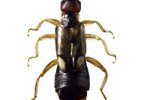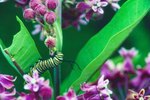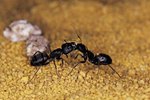
Moths are nocturnal, flying insects that primarily feed on flower nectar. They are completely inoffensive creatures that can’t bite or sting. Far from pests, moths are important to local ecosystems; they are food for a variety of insect-eating predators and effective pollinators for a number of plant species.
Moth Classification
Moths, together with butterflies and skippers, make up the order Lepidoptera. Containing some 160,000 described species of an estimated 500,000 total species, these insects are important components of ecosystems worldwide. Historically, these three groups were distinguished from one another by a variety of morphological and behavioral characteristics: butterflies are diurnal and have clubbed antennae; moths are nocturnal fliers that rest with their wings extended laterally; and skippers are moth-like in appearance, but diurnal. However, recent work suggests that these distinctions may not accurately represent evolutionary history; accordingly, the use of the terms "butterfly," "skipper" and "moth" are somewhat subjective.
Moth Mouths
Moths have a mouth that is modified into an apparatus called a proboscis. The proboscis is normally carried rolled up, resembling an upside-down party favor; when the moth lands on a flower, it straightens the proboscis and inserts it in the flower to siphon nectar. The Morgan’s sphinx moth (Xanthopan morgani) has the longest proboscis of any moth, reaching over 12 inches in length. Larval moths (caterpillars) do have biting mouthparts, but these cannot pierce the skin; exceptionally large species may be able to deliver a slight pinch.
Potentially Poisonous
Moths and butterflies are potentially dangerous to people in one context: eating them. While most butterflies and moths are likely non-toxic to hungry humans, a few species -- like the familiar monarch butterfly (Family Nymphalidae) -- feed on poisonous or unpalatable plants as larvae. Monarch caterpillars feed largely on milkweed, which contains cardenolides -- poisons that act on heart muscle. The insects store these poisons in their body, and if they are eaten, the predator will likely find them distasteful and potentially sickening. Because of the bold orange and black coloration of the butterflies, predators will often remember that they tasted bad, and therefore ignore them in the future. Despite the fact that some moths and butterflies have these sequestered toxins, butterflies are eaten by humans in some parts of Mexico and Asia.
Moth Lifecycle
Adult moths lay tiny eggs on leaves and twigs. These eggs hatch into larvae that are commonly called caterpillars. While moths are universally harmless, some caterpillars have stinging spines or hairs. Of particular note, the puss moth caterpillar (Megalopyge opercularis) is capable of delivering a severe sting. Though the symptoms commonly fade in a matter of minutes or hours, severe envenomation can produce symptoms lasting several days. The saddleback caterpillar (Sibine stimulea) and io moth (Automeris io) are also capable of delivering painful stings that are likened to fire. In Europe, the oak processionary moth (Thaumetopoea processionea) is increasing its range northward. The hairs of these caterpillars are particularly troubling because they can become airborne; the hairs are irritating when they touch the skin, but if inhaled they can cause allergic reactions.
References
- Animal Diversity Web: Lepidoptera
- Zootaxa: Lepidoptera Phylogeny and Systematics: the State of Inventorying Moth and Butterfly Diversity
- University of Sydney: Moth and Butterfly Mouthparts
- TheButterflySite.com: What Eats Butterflies?
- MailOnline.com: 'It's Like Somebody Lit You on Fire': First Pythons, Giant Rats and Crocodiles -- and Now Poisonous Caterpillars are the Scourge of Florida
- University of Auburn: Stinging Caterpillars A Guide to Recognition of Species Found on Alabama Trees
- New York Times: Caterpillars
- Annenberg Learner: Monarch Butterfly
Photo Credits
-
Comstock Images/Comstock/Getty Images




